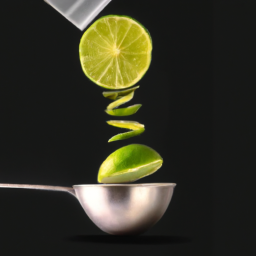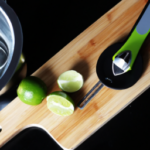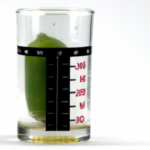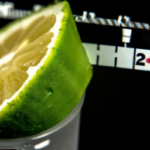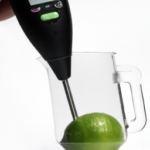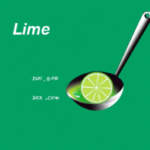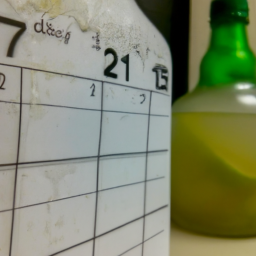Lately, when making guacamole, I realized I didn’t have enough lime juice. While cutting a lime in half, I started wondering how much juice I could get from just one side.
It got me thinking – how much lime juice is actually in half a lime? This seemingly simple question is actually more complex than it appears. There are a variety of factors that can affect the amount of juice a lime yields, from the ripeness of the fruit to the juicing method used.
In this article, we’ll explore the science behind lime juice yield and provide tips and tricks for maximizing the juice output from your limes. So, whether you’re making guacamole, squeezing lime wedges into a cocktail, or adding a splash of lime juice to a recipe, read on to learn how to get the most juice out of your limes.
Key Takeaways
- On average, 8-10 limes are required to make 1 cup of lime juice.
- Rolling limes on the countertop before slicing, slicing off the ends and cutting in half lengthwise can maximize juice yield.
- Using a citrus juicer can extract more juice with minimal effort.
- Lime yield can vary depending on size and ripeness.
Factors Affecting Lime Juice Yield
You’ll want to squeeze your lime thoroughly to get the most juice out of it, as factors such as ripeness and temperature can affect the yield. The acidity of the lime also plays a role in how much juice is produced. Limes that are more acidic tend to yield more juice than those that are less acidic.
Additionally, limes that are at room temperature or slightly warmer will produce more juice than those that are cold. Consuming lime juice has many benefits, including aiding in digestion and boosting the immune system. Therefore, it’s important to maximize the amount of juice you can get from a lime.
While there are many factors that can affect lime juice yield, a general rule of thumb is to expect about 1-2 tablespoons of juice from a half of a lime. With this amount in mind, you can adjust your recipes accordingly and ensure that you’re getting the most out of your limes.
General Rule of Thumb for Lime Juice Yield
Typically, when squeezing a lime, you can expect to get a decent amount of fresh tanginess. However, the amount of juice you get from a lime can vary depending on different factors. Here are some general rules of thumb to keep in mind when squeezing limes:
-
On average, one lime contains about 2 tablespoons of juice. However, this can vary depending on the size and ripeness of the lime.
-
Alternative sources of lime juice, such as bottled or frozen, may not have the same fresh taste as squeezing a lime yourself.
-
Measuring accuracy is important when using lime juice in recipes. It’s always best to use a measuring spoon to ensure you’re getting the right amount of juice.
When it comes to choosing the right limes, there are a few things to consider.
Choosing the Right Limes
When it comes to getting the perfect balance of tangy and sweet in your dish, it’s important to consider the type of limes you choose. There are two main types of limes: the Persian lime and the Key lime.
The Persian lime is the most commonly found in grocery stores and has a higher acidity than the Key lime. On the other hand, the Key lime is smaller and has a sweeter taste, making it ideal for desserts. Depending on your recipe, you may want to choose one type over the other.
Another factor to consider when choosing limes is their ripeness. Limes that are too ripe will have a softer texture and may not yield as much juice. On the other hand, underripe limes may not be as juicy and can be more difficult to juice.
To ensure you are choosing the best limes for your recipe, look for limes that are firm and have a bright green color. Additionally, make sure to store your limes in a cool, dry place, such as the refrigerator, to help them last longer and maintain their freshness.
When it comes to preparing limes for juicing, there are a few steps you can take to maximize your yield.
Preparing Limes for Juicing
To get the most out of your limes for juicing, try rolling them firmly on the countertop before slicing them open. This helps to break down the internal membranes of the lime, making it easier to extract the juice.
Before rolling the limes, it’s important to clean them thoroughly with water to remove any dirt or residue on the skin.
When cutting the limes, make sure to use a sharp knife to avoid squishing the fruit and losing juice. Begin by slicing off the ends of the lime, then cut it in half lengthwise. You can then cut each half into smaller sections for easier juicing.
With these preparation steps, you’ll be able to get the most juice out of your limes and maximize the flavor in your recipes.
To move onto the subsequent section about hand-squeezing limes, simply take one of the lime sections and firmly press it against a juicer or your hand, squeezing out the juice.
Hand-Squeezing Limes
When I hand-squeeze limes for juice, I position the lime halves in the palm of my hand with the cut side facing down. Then, I apply pressure to the lime and twist it back and forth to release as much juice as possible.
Once I’ve squeezed all the juice out, I strain it through a fine mesh strainer to remove any pulp or seeds.
Positioning the Lime Halves
Position the lime halves cut-side down on the cutting board to prevent them from rolling away while you juice them. This is the first step in properly squeezing limes.
Before applying pressure and twisting, it’s important that the lime halves are securely in place. Proper hand positioning is also key to getting the most juice out of each lime half.
Hold the lime with your non-dominant hand and use your dominant hand to squeeze and twist the lime half. This technique will ensure that you get the most juice possible from each lime half.
Did you know that it takes about 8-10 limes to make a single cup of lime juice? This is important information to keep in mind when preparing drinks or recipes that require lime juice.
By positioning the lime halves properly and using the correct technique for squeezing, you can maximize the amount of juice you get from each lime half. Applying pressure and twisting is the next step in the process of hand-squeezing limes.
Applying Pressure and Twisting
Now, as you firmly grip the lime in your non-dominant hand, press down with your dominant hand and twist to release all the zesty flavors and tangy goodness. This applying pressure technique allows the juice to flow out of the lime halves and into a waiting container. But how much juice can you expect to get out of half a lime using this method?
To answer this question, it’s helpful to look at a table that shows the average amount of juice in a single lime. According to the United States Department of Agriculture (USDA), one lime contains approximately 2 tablespoons (30 ml) of juice. Using the twisting technique, you can expect to get about half of this amount, or 1 tablespoon (15 ml), from each lime half. Of course, this can vary depending on the ripeness and size of the lime, as well as the amount of pressure applied during the twisting motion. With this in mind, let’s move on to the next step: straining the juice.
Straining the Juice
Once you’ve released all the zesty flavors and tangy goodness, it’s time to strain the freshly squeezed lime juice to ensure a smooth and pulp-free mixture that will add the perfect kick to your favorite recipes.
Straining techniques vary depending on the tools you have available, but here are three benefits of freshly squeezed juice that make it worth the extra effort:
-
More Nutrients: Freshly squeezed juice is packed with vitamins and minerals that are essential for maintaining a healthy body.
-
Better Taste: The flavor of freshly squeezed juice is superior to store-bought juice because it hasn’t been processed or preserved with additives.
-
No Added Sugar: When you make your juice at home, you have control over the amount of sugar that goes into your drink.
To get the most out of your lime, consider investing in a citrus juicer. This handy tool makes it easy to extract every last drop of juice from your fruit, and it’s much faster than squeezing by hand.
Using a Citrus Juicer
Hey, no need to break a sweat trying to squeeze the juice out of a lime by hand. Just grab a citrus juicer and let it do the work for you!
Using a citrus juicer has some benefits over hand squeezing. Firstly, you can extract more juice from the lime with minimal effort. The juicer presses down on the lime, maximizing the amount of juice you get. Additionally, it saves time and energy, especially when you need to juice a large quantity of limes.
To maintain and clean your citrus juicer, it’s best to rinse it with warm water after each use. This ensures that there is no leftover pulp or seeds that can clog up the juicer. It’s also important to disassemble the juicer and clean it thoroughly every few uses. Use a mild soap and a soft brush to scrub away any residue.
With proper care, your citrus juicer can last for years and provide you with fresh lime juice whenever you need it. Now, let’s move on to maximizing the juice yield from each lime.
Maximizing Juice Yield
Getting the most out of your citrus fruit is easy with these tips for maximizing juice yield. Juice extraction is crucial in getting the most out of your lime.
Lime varieties can have varying juice yields, so it’s important to choose a variety that is high in juice for your recipe. Bearss limes are a popular choice due to their high juice yield.
To maximize juice yield, try microwaving your lime for a few seconds to soften it up. Then, roll it on a hard surface with the palm of your hand to break down the membranes and release more juice. Finally, cut the lime in half and use a citrus juicer or a fork to extract as much juice as possible.
By following these steps, you can get the most out of your lime and ensure that your recipes are bursting with flavor.
When you have extracted all the juice from your lime, it’s important to store it properly to prevent spoilage.
Storing Lime Juice
I’ve found that there are a few key ways to store lime juice to ensure its freshness and flavor.
First, refrigerating fresh lime juice is essential to prevent spoilage and maintain its taste.
Second, freezing lime juice is an option if you want to extend its shelf life even further.
And finally, using lime juice in recipes is a great way to make use of any excess juice you may have, while also adding a bright, citrusy flavor to your dishes.
Refrigerating Fresh Lime Juice
Refrigerating fresh lime juice is crucial for keeping it from spoiling and losing its zesty flavor, so make sure to store it in an airtight container in your fridge.
Here are some benefits of adding lime juice to your skincare routine: it can help exfoliate dead skin cells, brighten your complexion, and even out skin tone. Additionally, using lime juice for household cleaning can help remove stains, deodorize surfaces, and sanitize kitchen appliances.
When it comes to freezing lime juice, it’s important to note that it can be frozen for up to six months without losing its flavor. However, freezing can cause the juice to lose some of its nutritional value, so it’s best to consume it fresh.
To freeze, simply pour the juice into an ice cube tray and pop it in the freezer. Once frozen, transfer the cubes to a freezer-safe container or bag for later use.
Freezing Lime Juice
To preserve the vibrant taste of fresh lime juice for longer periods, you should consider freezing it in small, convenient portions. Freezing lime juice is a great way to ensure that you always have some on hand when you need it. Plus, it’s a great way to save money by buying limes in bulk and juicing them all at once.
One of the benefits of freezing lime juice is that it can be used in a variety of recipes. From cocktails and marinades to sauces and dressings, frozen lime juice adds a burst of citrus flavor to any dish. Additionally, freezing lime juice is a great way to save time in the kitchen. Instead of juicing a lime every time a recipe calls for it, simply grab a cube of frozen juice and you’re good to go. With all of these benefits, freezing lime juice is definitely worth a try.
When it comes to using lime juice in recipes, there are endless possibilities. Whether you’re making a classic margarita, a zesty marinade for grilled chicken, or a refreshing salad dressing, lime juice adds a bright, citrusy flavor to any dish. Now that we know the benefits of freezing lime juice for later use, let’s explore some delicious recipes that make use of this versatile ingredient.
Using Lime Juice in Recipes
As we discussed earlier, freezing lime juice is a great way to extend the shelf life of your citrus fruit. But why stop there? There are so many delicious recipes that call for lime juice as a key ingredient, and incorporating it into your cooking can provide a variety of health benefits.
First and foremost, lime juice is an excellent source of vitamin C, which is essential for a healthy immune system. It also contains antioxidants that can help protect your body from damage caused by free radicals. Plus, the tart and tangy flavor of lime juice can add a refreshing twist to any dish.
Here are three recipes that make great use of lime juice:
-
Grilled Fish Tacos with Lime Crema – This classic Mexican dish is made even better with a drizzle of lime crema on top. Simply mix together sour cream, lime juice, and a pinch of salt for a creamy and tangy sauce that pairs perfectly with grilled fish.
-
Lime and Avocado Salad – This simple salad is a refreshing and healthy side dish that’s perfect for summer. Just toss together a mix of greens, diced avocado, and cherry tomatoes, and top with a dressing made from lime juice, olive oil, and honey.
-
Lime and Coconut Chicken Curry – This flavorful curry is a crowd-pleaser that’s easy to make. Simply sauté chicken in a curry paste made from coconut milk, lime juice, and spices like cumin and coriander. Serve over rice for a satisfying meal.
Incorporating lime juice into your cooking is a great way to add flavor and nutrition to your meals. Next, we’ll discuss some tips and tricks for using lime juice in your recipes to get the most out of this versatile citrus fruit.
Tips and Tricks for Using Lime Juice
Squeezing a fresh lime into your cocktail or dish can add a burst of zesty flavor that will make your taste buds dance with delight! But did you know that lime juice also has a variety of health benefits? It’s rich in vitamin C, antioxidants, and can even aid in digestion.
When using lime juice in recipes, there are a few tips and tricks to keep in mind. First, make sure to roll the lime on a hard surface before cutting it open. This will help to release more juice from the fruit. Secondly, use a citrus juicer or a fork to extract as much juice as possible. And finally, be creative with how you use lime juice in your recipes! It’s not just for cocktails – try adding it to dressings, marinades, or even desserts for a tangy twist.
| Emotion | Benefit |
|---|---|
| Refreshing | Lime juice can add a burst of flavor to any dish |
| Energizing | The vitamin C in lime juice can boost your immune system |
| Soothing | Lime juice can aid in digestion and reduce inflammation |
| Nostalgic | The tart taste of lime can transport you to a tropical paradise |
| Adventurous | Experimenting with lime juice in different recipes can lead to exciting new flavor combinations |
Incorporating these tips and tricks, as well as taking advantage of the creative uses and health benefits of lime juice, can elevate your culinary creations to the next level. So next time you’re in the kitchen, don’t be afraid to add a squeeze of lime to your dish – your taste buds and your body will thank you!
Frequently Asked Questions
How do I know if a lime is ripe and ready to use for juicing?
To pick a ripe lime, look for a smooth, shiny skin and a slightly soft texture. The best way to extract juice is to roll the lime on a hard surface before cutting and then use a citrus juicer or squeeze by hand.
Can I use bottled lime juice instead of fresh lime juice?
I prefer fresh lime juice over bottled as it has a brighter, more vibrant taste. The difference in taste is noticeable in cocktails and cooking. Bottled juice lacks the complexity and depth of fresh juice.
How long can I store freshly squeezed lime juice in the refrigerator?
I store freshly squeezed lime juice in the refrigerator for up to a week. Proper refrigeration is key to minimizing spoilage and maximizing freshness. Lime juice also acts as a natural preservative and offers health benefits beyond its culinary uses.
Is it necessary to strain the pulp and seeds from the lime juice before using it in recipes?
Did you know that the straining debate over lime juice has been ongoing for years? Some prefer to strain the pulp and seeds before using it in recipes, while others enjoy the added texture. It ultimately comes down to personal preference.
Are there any health benefits to consuming lime juice regularly?
Regular consumption of lime juice offers numerous health benefits, including improved digestion, immune system support, and skin health. Incorporating lime juice into recipes adds a refreshing citrus flavor to dishes, from salads to marinades.
Conclusion
In conclusion, determining the amount of lime juice in half a lime depends on various factors such as the type of lime, ripeness, and juicing method. However, as a general rule of thumb, one lime yields about 2 tablespoons of juice, which means half a lime will yield approximately 1 tablespoon of juice.
To maximize lime juice yield, it’s essential to choose the right limes and prepare them properly for juicing. Hand-squeezing limes is a simple and effective method, while using a citrus juicer can save time and effort. Properly storing lime juice can also prolong its shelf life and maintain its flavor.
With these tips and tricks, you can confidently measure the amount of lime juice needed for your recipes and enjoy the refreshing taste of lime in your drinks and dishes.
Ilana has been a vegan for over 10 years. She originally made the switch for health reasons, but soon found herself becoming more and more passionate about the ethical and environmental implications of a vegan lifestyle. Ilana is the author of The Graceful Kitchen, a blog all about veganism. She loves to cook up delicious and nutritious vegan meals, and share her recipes with others who are interested in leading a cruelty-free life. Ilana is also a strong advocate for using whole foods as the foundation of a healthy diet, and believes that going vegan is one of the best ways to achieve this.
